纳扎雷灯塔,葡萄牙 Nazaré Lighthouse atop Forte de São, Nazaré, Portugal (© Richard A Lock/Getty Images)

纳扎雷灯塔,葡萄牙 Nazaré Lighthouse atop Forte de São, Nazaré, Portugal (© Richard A Lock/Getty Images)
Nazaré Lighthouse
The iconic surf beaches of the world sit predominantly on the Pacific, but we're in the dead of shredding season on the Atlantic. Stormy winters from October to March beckon surfers donning their thickest wetsuits to brave gargantuan breaks here in Nazaré, Portugal. Brazilian surfer Rodrigo Koxa caught an 80-footer here in 2017, beating the previous Guinness World Record for surf wave height—also set here. Meanwhile, those less daredevilish among us are content to join this crowd standing in awe from the safety of Nazaré's Forte de São, a lighthouse-topped fortress on a shoreside cliff.
纳扎雷灯塔
世界上标志性的冲浪海滩主要坐落在太平洋上,但我们正处于大西洋破碎季节的死期。在葡萄牙纳扎雷,从10月到3月,暴风雨的冬天召唤着冲浪者穿上他们最厚的潜水服,勇敢地在这里进行巨大的休息。2017年,巴西冲浪运动员罗德里戈·科萨在这里捕获了一个80英尺高的冲浪者,打破了此前同样在这里创造的冲浪波高吉尼斯世界纪录。与此同时,我们当中那些胆小的人也很乐意加入到这群人当中,他们敬畏纳扎雷的圣堡堡(Forte de são)的安全,这是一座位于岸边悬崖上的灯塔式堡垒。
马德拉岛的法纳尔森林,葡萄牙 The Fanal Forest on Madeira Island, Portugal (© Val Thoermer/Alamy)
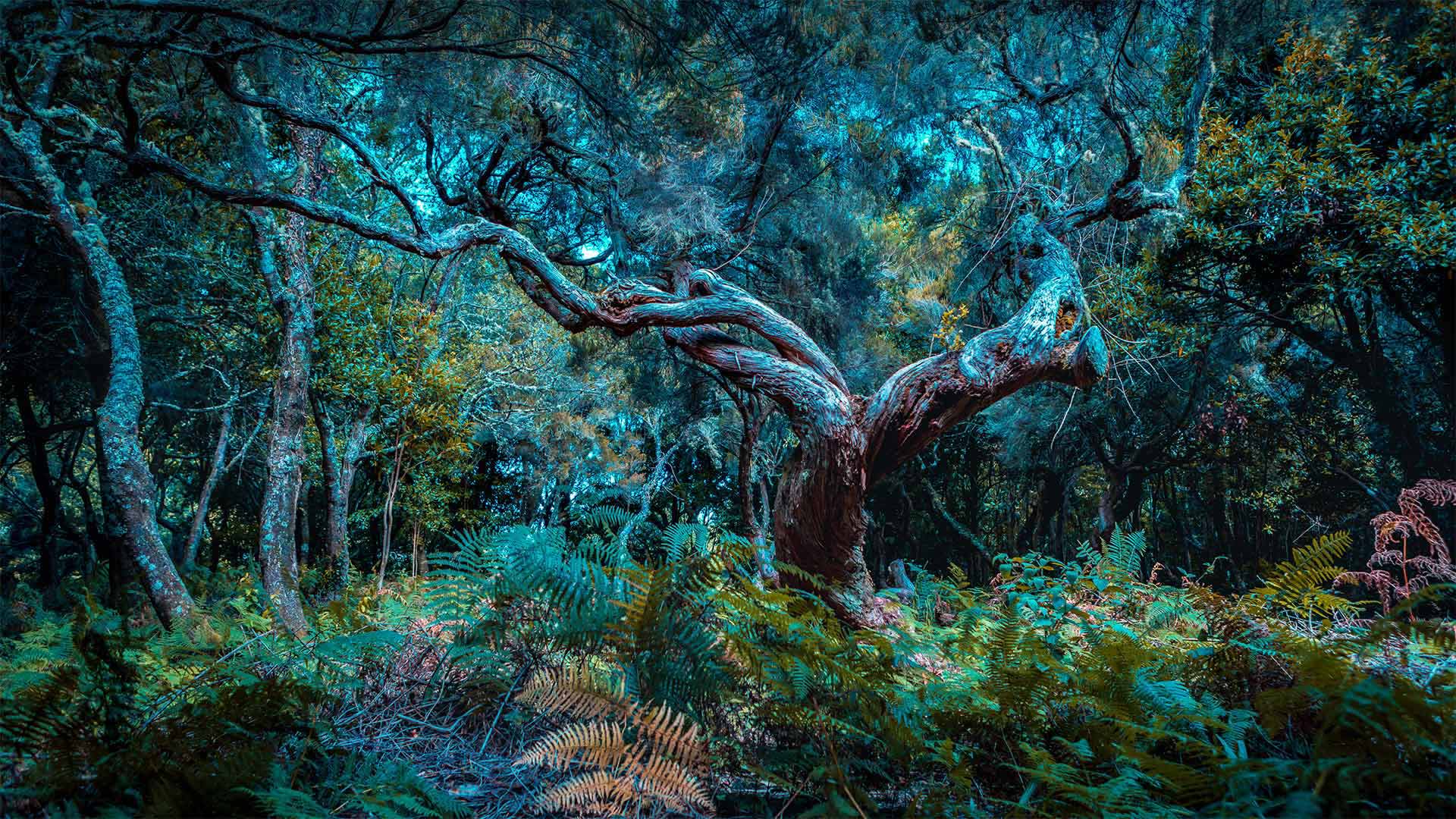
马德拉岛的法纳尔森林,葡萄牙 The Fanal Forest on Madeira Island, Portugal (© Val Thoermer/Alamy)
These laurels are hardy
Go back 15 million years and you'll find most of Southern Europe looking like this fantasy forest: thick, scrubby underbrush canopied by wizened laurel trees. An epoch or two of human agricultural advances cleared those ancient woods, but patches persist on a few temperate Atlantic islands—Especially here on Madeira, a Portuguese-held island off northwest Africa.
The Fanal Forest, at almost 60 square miles, is the largest surviving laurel forest in the world. Ninety percent of the forest's growth remains uncut, and some of these long-in-the-root laurels have stood for 500 years.
这些桂冠很耐寒
追溯到1500万年前,你会发现欧洲南部的大部分地区都像是一片梦幻森林:茂密的灌木丛中覆盖着干枯的月桂树。人类农业的进步使这些古老的森林消失了一两个世纪,但在一些温带大西洋岛屿上,特别是在非洲西北部葡萄牙控制的马德拉岛上,仍然存在着一些斑块。
法纳尔森林面积近60平方英里,是世界上现存最大的月桂林。森林生长的百分之九十没有被砍伐,其中一些长根月桂已经存在了500年。
贝纳吉尔洞穴,葡萄牙阿尔加维 Benagil Cave in the Algarve, Portugal (© Michael Malorny/Offset by Shutterstock)
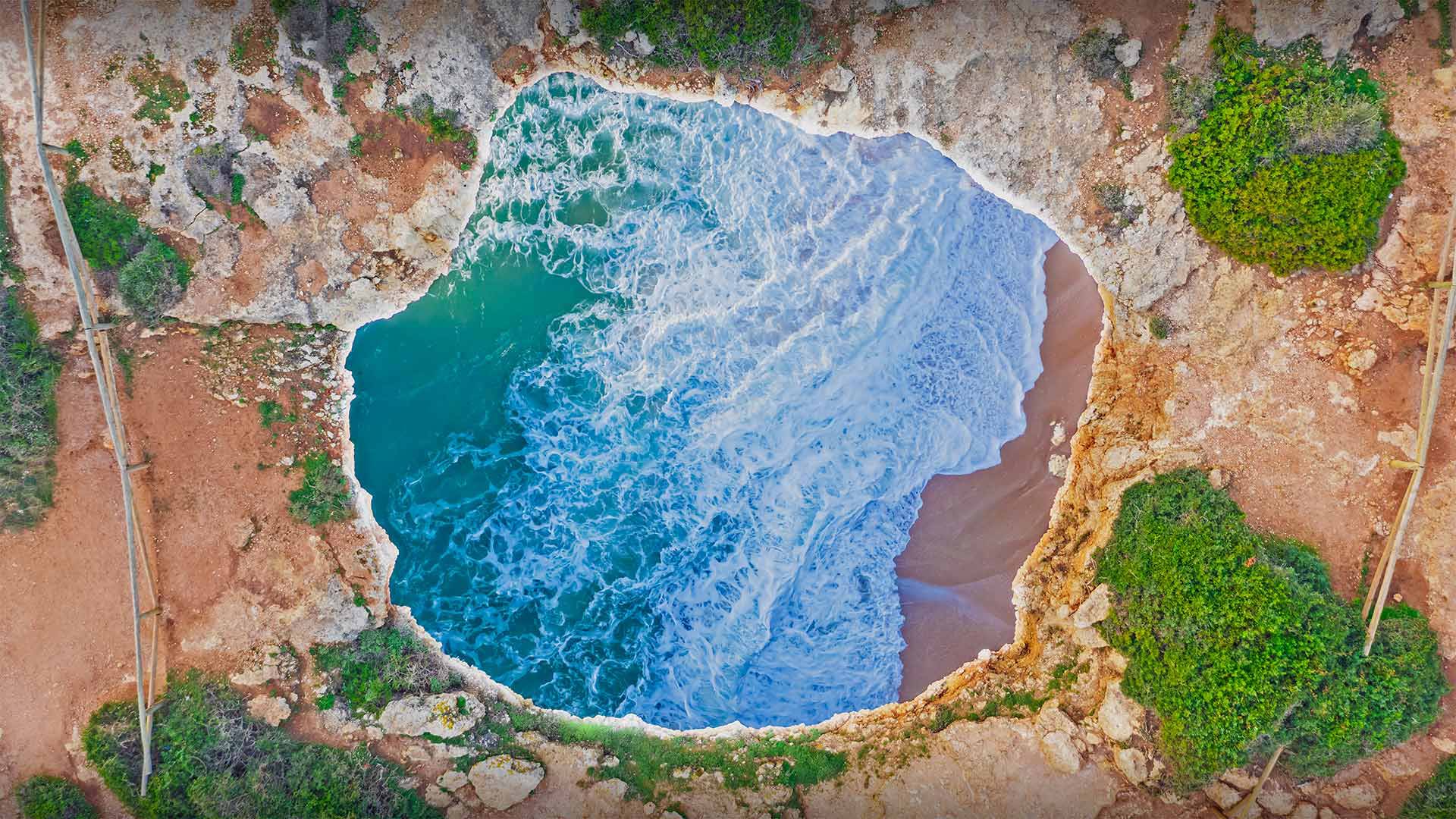
贝纳吉尔洞穴,葡萄牙阿尔加维 Benagil Cave in the Algarve, Portugal (© Michael Malorny/Offset by Shutterstock)
Eye of the cave
Many sea caves and rock formations line the alluring Algarve coast in the south of Portugal, and today we’re shedding light on Benagil Cave—one of the region’s most spectacular and famous natural landmarks. Just east of the small fishing village of Benagil, the cave was formed about 20 million years ago from the pounding waves that sweep in from the Atlantic. Rainfall has caused the softer segments of limestone to erode, creating a giant hole in the cave’s roof, which is what we’re looking down through in our photo.
The eye-shaped opening allows sunlight to stream into the cave, illuminating the golden beach and azure waters within its layered walls. The only way to explore the inside is by sea, so visitors need to hop on a boat, kayak, or paddleboard to enter the grotto.
洞眼
葡萄牙南部迷人的阿尔加维海岸沿线有许多海洞和岩层,今天我们将向大家展示该地区最壮观、最著名的自然地标之一贝纳吉尔洞穴。就在小渔村贝纳吉尔的东面,这个洞穴是大约2000万年前由大西洋拍打而来的海浪形成的。降雨导致较软的石灰岩段被侵蚀,在洞穴顶部形成了一个巨大的洞,这就是我们在照片中看到的。
眼睛形状的开口让阳光流入洞穴,照亮了分层墙内的金色海滩和蔚蓝的海水。探索洞穴内部的唯一方法是通过海上,因此游客需要跳上小船、皮划艇或桨板才能进入洞穴。
葡萄牙波尔图的莱洛书店 Livraria Lello in Porto, Portugal (© Nido Huebl/Shutterstock)

葡萄牙波尔图的莱洛书店 Livraria Lello in Porto, Portugal (© Nido Huebl/Shutterstock)
Enter the magical world of Livraria Lello
How will you celebrate International Literacy Day today? We're highlighting this important observance with a photo of a very special bookstore, Livraria Lello in Porto, Portugal. With its Art Nouveau façade, Neo-Gothic interior, stained-glass ceiling, swooping catwalks, and the dramatic, curvaceous staircase with crimson steps, the Lello is considered one of the most beautiful—and among the oldest—bookstores in the world. If rumors are true, the bookstore cast a spell on J.K. Rowling, inspiring scenery in 'Harry Potter,' such as the Hogwarts floating staircase and the Flourish and Blotts bookshop. (Rowling often visited the Lello when she lived in Porto in the early '90s.) The Lello bookstore opened in 1906 and has been serving up the magic of books ever since.
进入莱洛书店的魔法世界
你们今天将如何庆祝国际扫盲日?我们用葡萄牙波尔图一家非常特别的书店Livraria Lello的照片来强调这一重要的纪念活动。Lello书店拥有新艺术风格的外立面、新哥特式的内部、彩色玻璃天花板、俯冲的T型台和带有深红色台阶的戏剧性曲线美楼梯,被认为是世界上最美丽、最古老的书店之一。如果传闻属实,书店会对J.K.罗琳施下咒语,激发《哈利波特》中的灵感,比如霍格沃茨浮动楼梯和繁荣与布洛茨书店。(罗琳在90年代初住在波尔图时经常参观莱洛书店。)莱洛书店于1906年开业,从那时起就一直在提供书籍的魔力。
镶嵌在巨石之间的石屋,葡萄牙 Casa do Penedo (House of the Rock) in Portugal (© Olimpio Fantuz/eStock Photo)
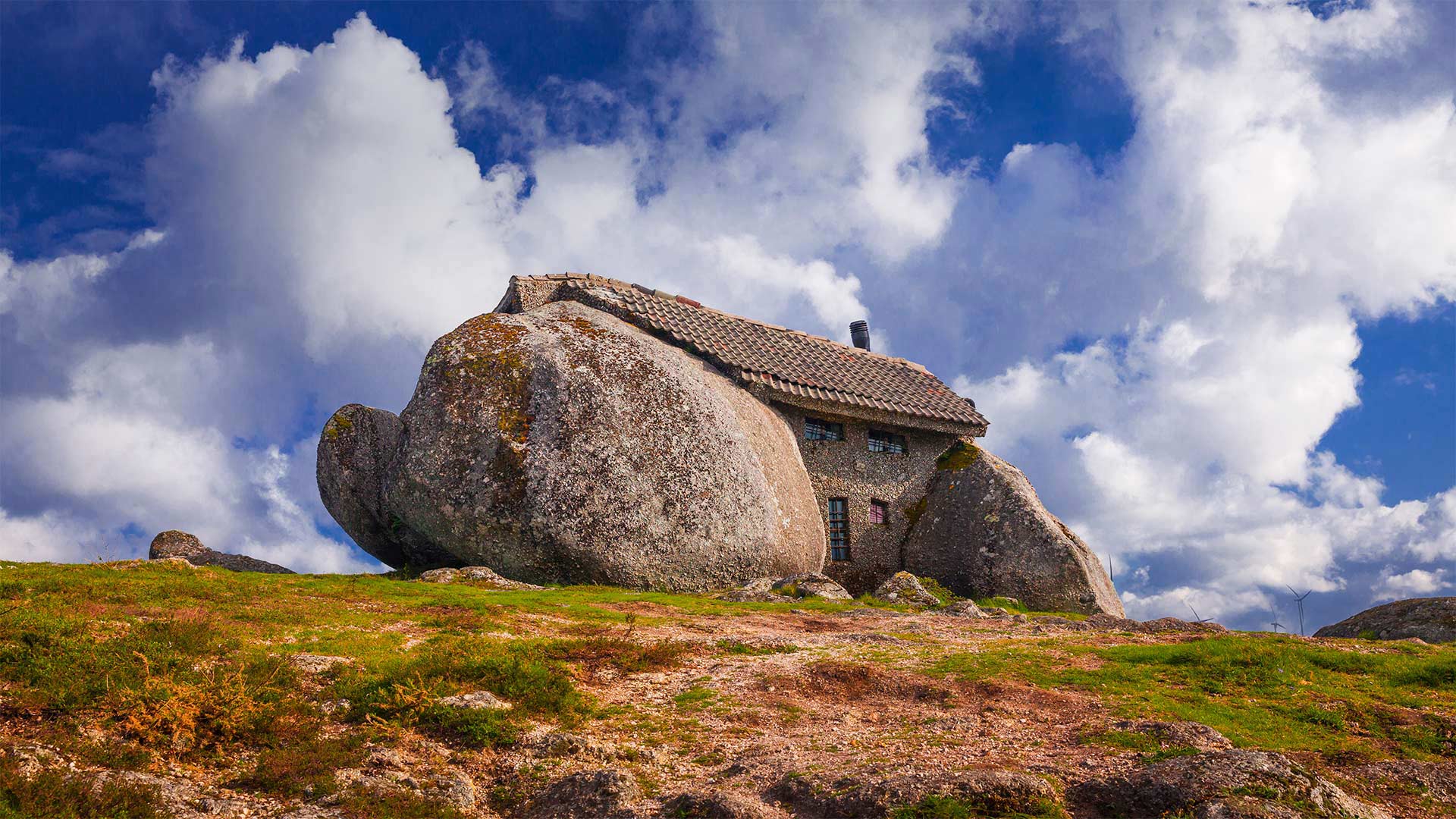
镶嵌在巨石之间的石屋,葡萄牙 Casa do Penedo (House of the Rock) in Portugal (© Olimpio Fantuz/eStock Photo)
Yabba-Dabba-Doo!
This rock-solid house in the Fafe mountains of northwest Portugal looks like it could be the home of a modern Stone Age family. Known locally as Casa do Penedo (House of the Rock), its prehistoric appearance has drawn comparisons to the Flintstones' dwelling from the fictional town of Bedrock. But the secluded stone structure on our homepage is very much real—it was built as a rural retreat in the Portuguese countryside in the 1970s. The building is sandwiched between four boulders that serve as the foundation, walls, and ceiling of the house, blending in as part of the beautiful natural landscape.
It may appear small on the outside, but inside there are two floors, comprising a kitchen, living room, bathroom, and bedrooms—just enough space for a family and their pet dinosaur. Many of the rustic fittings, including furniture, stairs, and handrails, are made of logs. There's no electricity, but there is a stone fireplace and even a small outdoor swimming pool carved out of one of the rocks. The quirkiness of the building has attracted plenty of curious visitors over the years, leaving the owners between a rock and a hard place. Due to an influx of tourists, Casa do Penedo can no longer be used as a peaceful getaway and has even been equipped with bulletproof windows and a steel door to fend off vandals. Today it functions as a small museum with relics and photographs from the house's history.
雅巴达巴嘟嘟!
这座位于葡萄牙西北部法夫山脉的坚固岩石房子看起来像是一个现代石器时代家庭的家。它的史前外观在当地被称为“岩石之屋”(Casa do Penedo),与虚构的基岩镇上的弗林茨通家的住宅相比,它的史前外观更具吸引力。但我们主页上的隐蔽的石头结构非常真实,它是1970年代在葡萄牙农村作为一个乡村休养地建造的。该建筑被夹在四块巨石之间,作为房屋的基础、墙壁和天花板,融入了美丽自然景观的一部分。
它外表看起来可能很小,但里面有两层,包括厨房、客厅、浴室和卧室,刚好足够一个家庭和他们的宠物恐龙居住。包括家具、楼梯和扶手在内的许多乡村配件都是由原木制成的。这里没有电,但有一个石制壁炉,甚至还有一个由岩石雕刻而成的小型室外游泳池。多年来,这座建筑的奇特之处吸引了大量好奇的游客,让业主们进退两难。由于大量游客涌入,佩内多之家不再能作为一个和平的避风港,甚至还配备了防弹窗和钢门来抵御破坏公物者。今天,它作为一个小型博物馆,收藏着这座房子历史上的文物和照片。
海浪撞击费尔盖拉什灯塔,葡萄牙波尔图 Wave crashing on Farolim de Felgueiras, a lighthouse in Porto, Portugal (© Stephan Zirwes/Offset by Shutterstock)
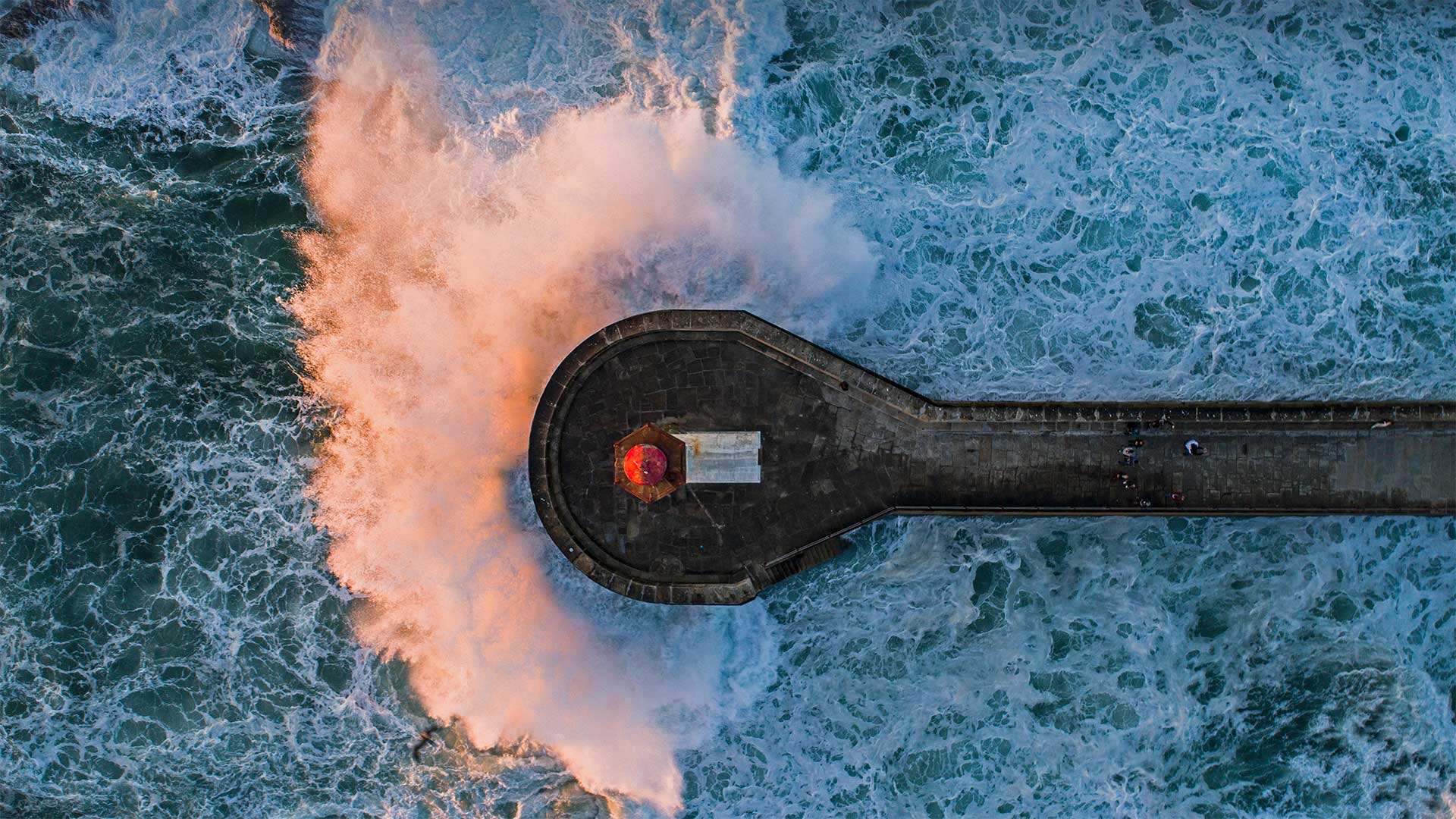
海浪撞击费尔盖拉什灯塔,葡萄牙波尔图 Wave crashing on Farolim de Felgueiras, a lighthouse in Porto, Portugal (© Stephan Zirwes/Offset by Shutterstock)
A lofty lighthouse and a little ocean spray
The Farolim de Felgueiras (Lighthouse of Felgueiras) you see here has withstood relentless waves for around 135 years. It offered its solitary warnings to ships approaching Porto, Portugal's second-largest city, beginning in 1886 until it was finally deactivated in 2009. Even though it's no longer operational, it's still a well-known local landmark. It offers sightseers a beautiful view, and maybe a little ocean spray, from its perch overlooking the mouth of the Douro river where it flows into the Atlantic.
The nearby city of Porto was originally established in around 136 BCE by the Romans as an outpost called Portus Cale, which is believed to be the origin of the name Portugal. The city is also responsible for the name of one of the country's most famous exports, Port wine, the (usually) sweet red fortified wine that was first exported by local merchants across Europe in the second half of the 17th century. These days the city and surrounding municipalities are home to around 1.7 million people, but Porto retains its historic charm. One of its oldest riverside neighborhoods, the Ribeira, was honored as a World Heritage Site by UNESCO in 1996 and was also designated as a National Monument of Portugal.
一座高耸的灯塔和一点浪花
你在这里看到的费尔盖拉灯塔(Farolim de Felgueiras)经受了大约135年无情的海浪。它从1886年开始向接近葡萄牙第二大城市波尔图的船只发出单独警告,直到2009年最后关闭。尽管它已经停止运作,但它仍然是当地著名的地标。它为观光客提供了一个美丽的景色,也许还有一点海洋浪花,从它的栖息处俯瞰着杜罗河口,杜罗河口流入大西洋。
附近的城市波尔图最初由罗马人在公元前136年左右建立,作为一个前哨站,称为波尔图卡尔,这被认为是葡萄牙这个名字的起源。这座城市也是该国最著名的出口商品之一,波尔图葡萄酒(Port wine)的名字的来源,波尔图葡萄酒(Port wine)是一种(通常)甜红色的强化葡萄酒,17世纪后半叶,当地商人首次在欧洲各地出口。如今,这座城市和周围的市政当局居住着大约170万人,但波尔图仍然保持着它的历史魅力。里贝拉是最古老的河畔社区之一,1996年被联合国教科文组织列为世界遗产,并被指定为葡萄牙国家纪念碑。
埃尔瓦什附近的格拉萨圣母堡,葡萄牙 Nossa Senhora da Graça Fort near Elvas, Portugal (© Luis Pina Photography/Shutterstock)
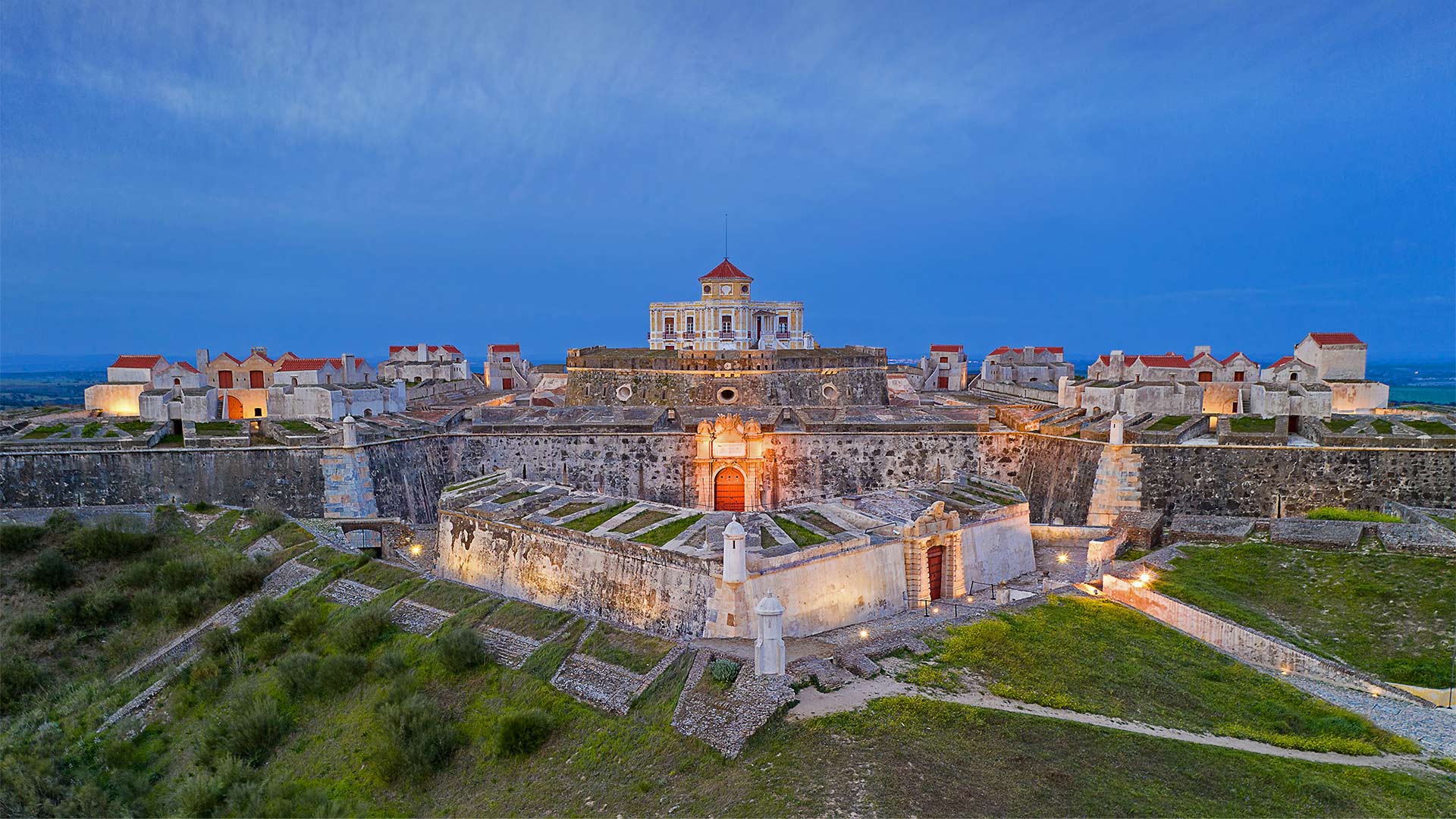
埃尔瓦什附近的格拉萨圣母堡,葡萄牙 Nossa Senhora da Graça Fort near Elvas, Portugal (© Luis Pina Photography/Shutterstock)
A Portuguese fort takes a star turn
Perched on a strategic hillside, high above the hot, dry plains of eastern Portugal, the Nossa Senhora da Graça Fort has been called a masterpiece of 18th-century military architecture. The thick wall that surrounds the fortress are shaped in a star pattern, with pentagonal bastions jutting out from the curtain wall at the corners. We're looking at one of those bastions in the center of our image.
A stone's throw from the Spanish border, the Nossa Senhora da Graça Fort was built to defend the garrison border town of Elvas. It's a region shaped by war. The Spanish laid siege to the area during the Portuguese Restoration War (1640-1668), but after the Nossa Senhora da Graça Fort was built a century later, the town was never defeated. With its 144 cannons, the fort resisted an attack by another wave of Spanish forces during the 1801 War of the Oranges and 10 years later drove back an invading French army during the Peninsular War.
Eventually the fort became a political prison, which it remained until 1974, when it was abandoned and fell into ruin. But it was restored after 2012, when UNESCO recognized the entire historical center of Elvas—including the Nossa Senhora da Graça Fort, a few other nearby forts, and the 16th-century Amoreira Aqueduct—as a World Heritage Site.
葡萄牙要塞有一个星形转弯
坐落在战略山坡上,高出葡萄牙东部炎热干燥的平原,Nossa Senhora da Graç堡垒被称为18世纪军事建筑的杰作。围绕堡垒的厚墙呈星形,五角形堡垒从墙角的幕墙中伸出。我们看到的是图像中心的一个堡垒。
离西班牙边境只有一箭之遥,Nossa Senhora da Graç一座堡垒是为了保卫守军边境城镇埃尔瓦斯而建的。这是一个战争形成的地区。在葡萄牙复辟战争(1640-1668)期间,西班牙人包围了该地区,但在诺萨塞诺拉大格拉之后ç一个世纪后建了一座堡垒,这个城镇从未被打败。在1801年的橘子战争中,这座拥有144门大炮的堡垒抵抗了西班牙军队的另一波进攻,10年后在半岛战争中击退了入侵的法国军队。
最终,这座堡垒变成了一座政治监狱,一直保留到1974年,当时它被遗弃并陷入废墟。但在2012年联合国教科文组织承认整个埃尔瓦斯历史中心,包括诺萨塞诺拉达格拉之后,它被修复了ç一个堡垒,附近的其他几个堡垒,以及16世纪的阿莫雷拉渡槽作为世界遗产。
马德拉岛的北海岸,葡萄牙 The north coast of Madeira, Portugal (© Hemis/Alamy)
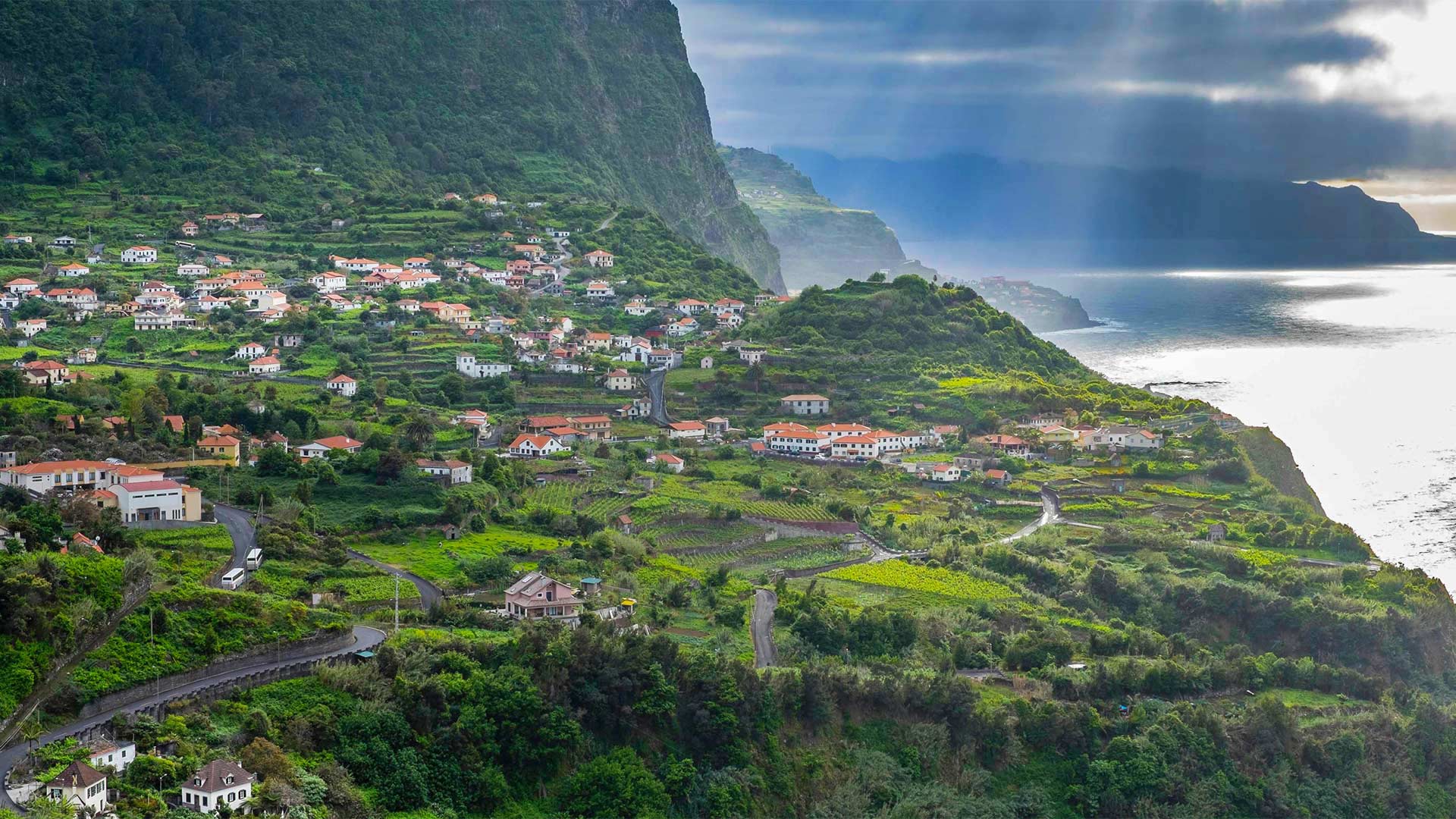
马德拉岛的北海岸,葡萄牙 The north coast of Madeira, Portugal (© Hemis/Alamy)
Exploring the 'Pearl of the Atlantic'
We're taking a view of the island of Madeira, by far the largest island in the Madeira archipelago, which sits 320 miles off the coast of Morocco in the North Atlantic. Part of an autonomous region of Portugal, Madeira, known as the 'Pearl of the Atlantic,' boasts a diverse forest ecosystem, endemic flora and fauna, and the largest living stand of laurel trees in the world. It's a great place to hike, too. Trails run alongside irrigation channels, called levadas, that move water all over the island. Walks range from easy strolls in the countryside to precarious hikes along mountain ridges or into remote parts of the forests. Afterward, the calorie-depleted can dig into a local delicacy like peixe espada com banana (fried local fish with banana) and sip on Madeira wine. Saúde!
探索“大西洋明珠”
我们正在观看马德拉岛,这是迄今为止马德拉群岛中最大的岛屿,位于北大西洋摩洛哥海岸320英里外。作为葡萄牙自治区的一部分,被称为“大西洋明珠”的马德拉拥有多样化的森林生态系统、特有的动植物群和世界上最大的活月桂林。这也是徒步旅行的好地方。小径沿着被称为levadas的灌溉渠延伸,这些灌溉渠将水输送到全岛。散步的范围从乡村的轻松漫步到沿着山脊或进入森林偏远地区的危险徒步旅行。之后,消耗掉的热量可以吃到当地的美味,比如peixe espada com香蕉(用香蕉炸当地鱼),然后啜饮马德拉葡萄酒。萨乌德!
波尔图,葡萄牙 Porto, Portugal (© Kanuman/Shutterstock)
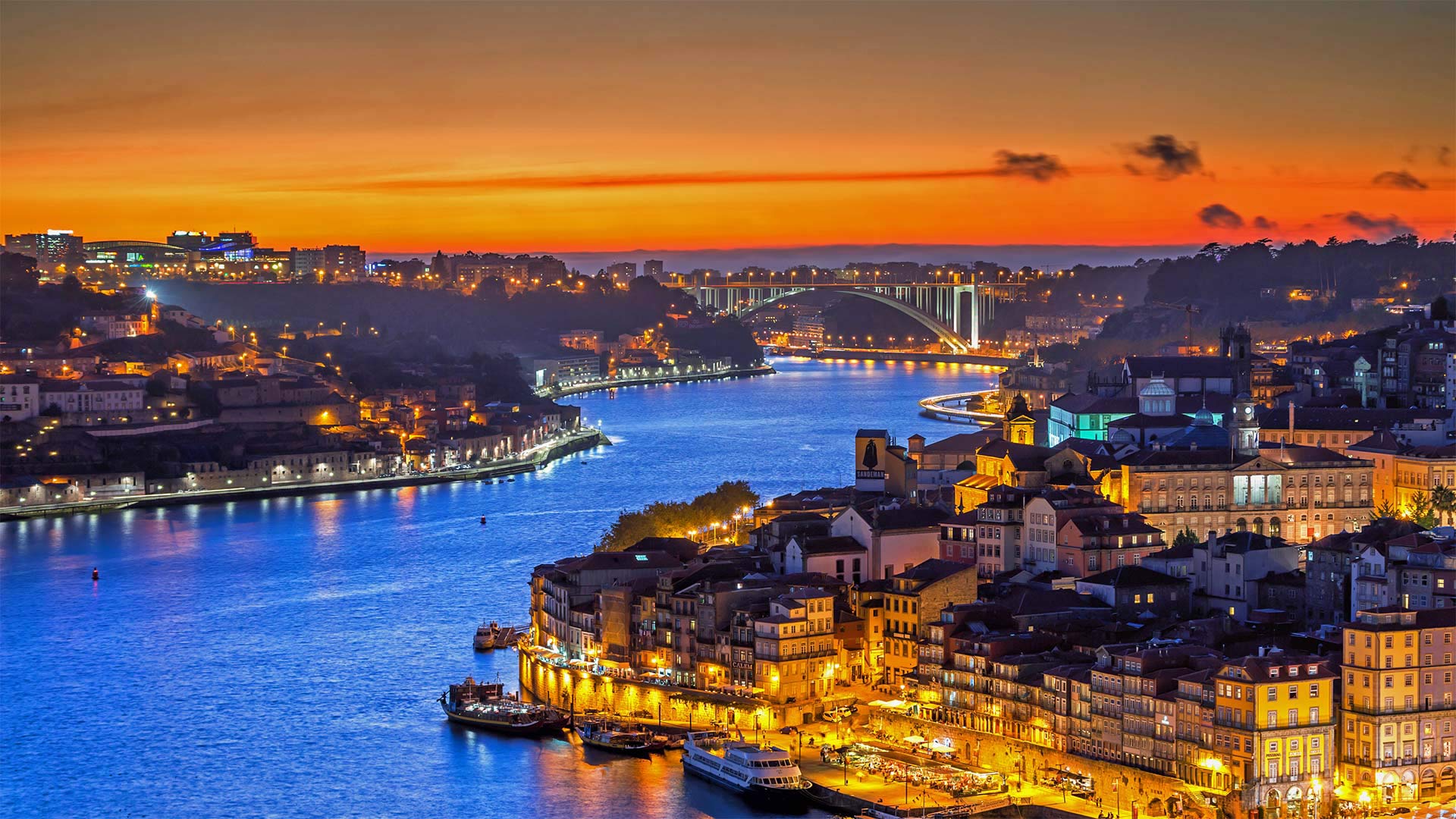
波尔图,葡萄牙 Porto, Portugal (© Kanuman/Shutterstock)
An important port of Portugal
Welcome to Porto, the second city of Portugal. Known on some English-language maps as Oporto (the Portuguese call it 'o Porto' in conversation, meaning simply 'the Port'), this attractive, ancient city is most famous today not for the port itself but for what's shipped out of it.
Follow this river, the Douro, east out of the city and you'll soon enter a valley flanked by vineyard-covered embankments. This long, narrow wine country is where world-renowned port wine is produced: A smooth, typically red wine fortified with a grape brandy to halt fermentation, resulting in a sweeter beverage. Douro valley vintners send their product downriver to Porto, from which it ships off to dessert tables worldwide. To be called port, the wine must come from the Douro valley—a stipulation dating to the 1750s—making the area one of the world's oldest protected wine regions.
葡萄牙的一个重要港口
欢迎来到葡萄牙第二大城市波尔图。在一些英文地图上被称为“波尔图”(葡萄牙人在对话中称之为“波尔图”,意思简单地说就是“港口”),这座迷人的古城今天最著名的不是港口本身,而是从港口运出的东西。
沿着这条河,杜罗河,向东出城,你很快就会进入一个山谷,山谷两侧是葡萄园覆盖的堤岸。这个狭长的葡萄酒之乡出产世界闻名的波尔图葡萄酒:一种光滑的,典型的红酒,用葡萄白兰地强化以停止发酵,从而得到更甜的饮料。杜罗谷葡萄酒商把他们的产品送到下游的波尔图,从那里运到世界各地的甜点桌上。要被称为港口,葡萄酒必须来自杜罗河谷——这一规定可以追溯到1750年代,使该地区成为世界上最古老的葡萄酒保护区之一。
Rodrigo Koxa riding the biggest wave ever surfed, on Nov 8, 2017, off the coast of Nazaré, Portugal (© Pedro Cruz/AP Photo)
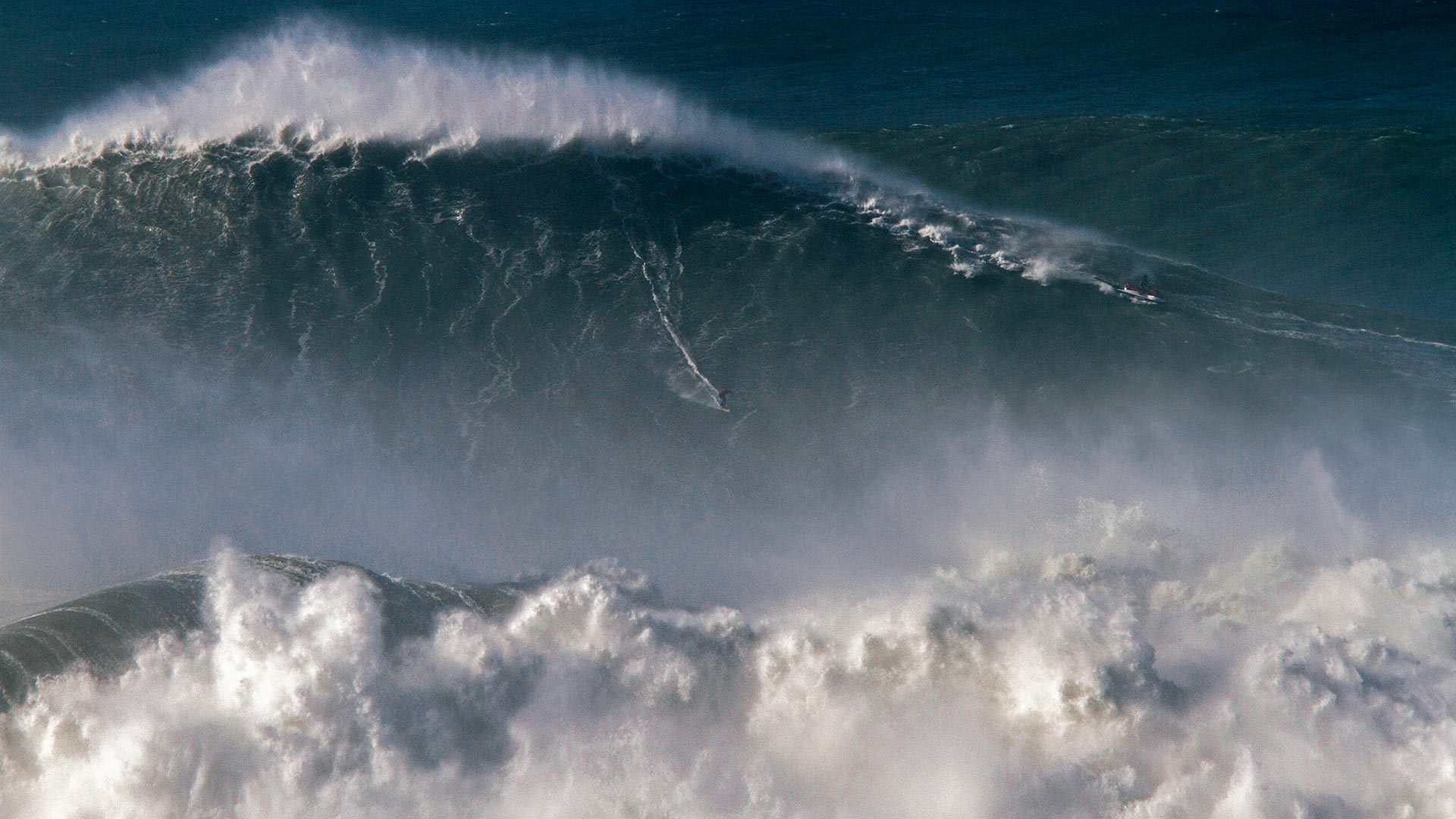
Rodrigo Koxa riding the biggest wave ever surfed, on Nov 8, 2017, off the coast of Nazaré, Portugal (© Pedro Cruz/AP Photo)
Big wave hunters watch Nazaré
Today's image captures Brazilian surfer Rodrigo Koxa in action, surfing a record 80-foot wave off the coast of Nazaré, Portugal. Nazaré began attracting surfers to the area in the 1960s and has since become a major destination for men and women who want to surf some of the world's biggest waves. Nazaré's Praia do Norte (North Beach) is the site of the two latest records for largest wave ever surfed. The previous record was set by American Garrett McNamara on November 1, 2011, when he rode a 78-foot wave here. Then, on November 8, 2017, Koxa set a new record with this ride.
Surfers' ability to catch these giant waves is a relatively new accomplishment that's made possible by using a watercraft, usually a Jet Ski or a helicopter, to tow a surfer into the wave. This time of year, with the return of the big-wave season, surfers from around the world are descending on this seaside town with their support teams. Together, they anxiously await the optimal conditions required to create these monster waves, hoping for an opportunity to test their skills and see their names added to the record book.